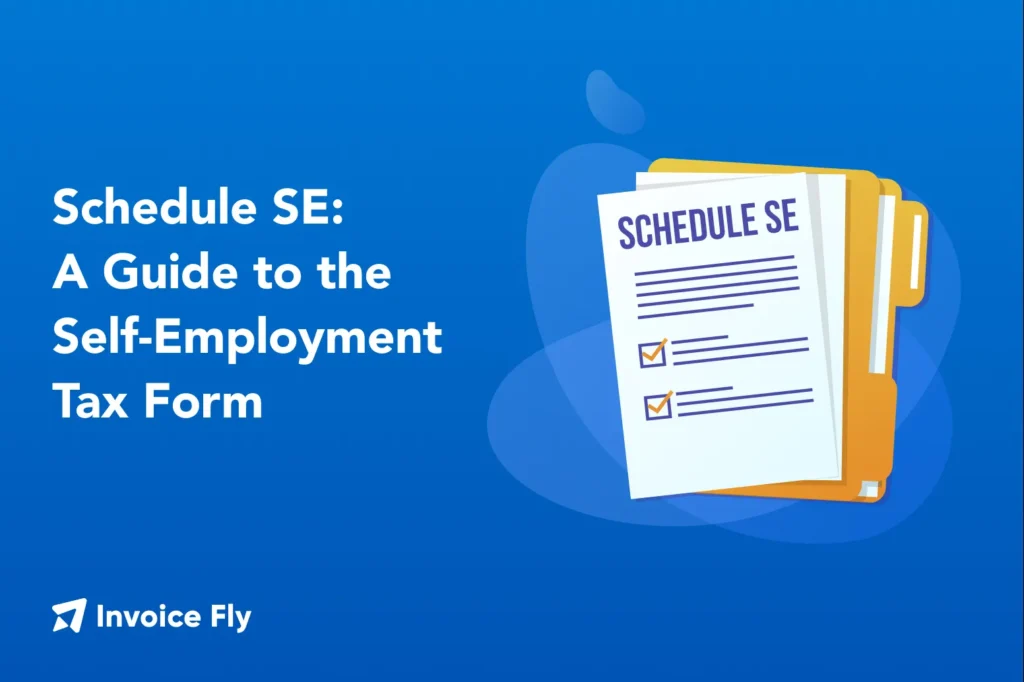Schedule SE: A Guide to the Self-Employment Tax Form

Table of Contents
- What is Schedule SE?
- Who Needs to File Schedule SE?
- Do I Need to Pay the Self-Employment Tax?
- What is Self-Employment Income?
- Where Do I Find My Self-Employment Income?
- What Does Schedule SE Look Like?
- What is the Self-Employment Tax?
- Breakdown of Social Security and Medicare Tax Rates
- How Do I Report the Self-Employment Tax?
- Should I File Estimated Taxes?
- How to Fill Out Schedule SE
- Can I Deduct Self-Employment Tax? And if So, How Much?
- Final Thoughts
- FAQs About Schedule SE Taxes
If you’re self-employed as a freelancer, independent contractor, or side hustler, you’re responsible for paying self-employment tax. That’s where Schedule SE comes in.It’s the IRS form used to calculate Social Security and Medicare tax based on your net earnings.
This updated 2025 guide explains who needs it, how to fill it out alongside your 1040 SE form, and key planning tips for staying compliant and saving.

What is Schedule SE?
Schedule SE (Self-Employment Tax) is part of Form 1040. The IRS requires you to calculate and pay both the employer and employee portions of Social Security and Medicare. The internal revenue guidelines require you to pay both the employer and employee portions of these taxes, totaling up to 15.3% on net earnings of $400 or more.

Who Needs to File Schedule SE?
You must file Schedule SE if you:
- Made $400 or more in net earnings from self-employment
- Are a sole proprietor, freelancer, contractor, or part of a partnership
- Received a 1099-NEC or 1099-K form for freelance or gig work
- Earned income through gig economy platforms
According to the IRS guidelines, even with a W‑2 job, side hustle income is subject to SE tax.
Do I Need to Pay the Self-Employment Tax?
Yes. If your net self-employment income is $400 or more. This tax applies regardless of your age or whether you’re already receiving Social Security benefits.
The self-employment tax rate is currently 15.3% (12.4% Social Security + 2.9% Medicare) of your net earnings. But here’s the key detail: you don’t pay this tax on your full earnings.
Instead, you pay the 15.3% rate on 92.35% of your net earnings from self-employment. This 92.35% calculation accounts for the employer-equivalent portion of the tax that regular employees don’t see on their paychecks.
Example: If your net self-employment income is $50,000, you’ll pay self-employment tax on $46,175 ($50,000 × 0.9235), which equals about $7,065 in self-employment tax. This built-in reduction saves you approximately $585 compared to paying the full 15.3% on your entire income.
Many newly self-employed people are surprised by their tax bills because they’re suddenly carrying the full burden of paying for Social Security and Medicare. When you’re an employee, you share this cost with your employer. But as a self-employed person, you’re responsible for the entire amount.
What is Self-Employment Income?
Self-employment income includes earnings from:
- Freelance work and consulting services
- Gig economy jobs (like driving for Uber or delivering for DoorDash)
- Side hustles or small businesses
- Farming or agricultural work
- Partnership income from business ventures
It does not include wages from a regular W-2 job or income from investments like stocks or rental properties. The key distinction is that self-employment income comes from work you perform for yourself rather than as an employee.
Where Do I Find My Self-Employment Income?
- Schedule C (Line 31): Net profit for sole proprietors
- Schedule K‑1 (Line 14a): Partnership income
- Schedule F (Line 34): Farm income
What Does Schedule SE Look Like?
Schedule SE has two main sections:
- Short Schedule SE: Suitable for most self-employed taxpayers
- Long Schedule SE: For special situations (e.g., church employee income, tips not reported to employers, or wages from certain tax-exempt organizations)
Both include the same key areas:
- Net earnings calculation section
- Tax rate application area
- Final self-employment tax computation
- Deduction calculation for your 1040 tax return
The irs gov website provides downloadable copies of the current year’s form, which typically spans two pages with clear instructions for each line.
What is the Self-Employment Tax?
The self-employment tax is how you contribute to Social Security and Medicare as a self-employed individual. It’s essentially the equivalent of payroll taxes that regular employees pay, except you’re responsible for the entire amount.
Breakdown of Social Security and Medicare Tax Rates
| Component | Rate | Cap / Notes |
| Social Security | 12.4% | Applies up to $168,600 (2024) / $176,100 (2025) |
| Medicare | 2.9% | No cap; +0.9% for high income |
| Total Possible Rate | 15.3% | On 92.35% of net earnings |
Chart showing breakdown of Social Security and Medicare tax rates for self-employment in 2025, including 12.4% for Social Security and 2.9% for Medicare
For more detailed information, see IRS Tax Topic 554: The Self-Employment Tax.
How Do I Report the Self-Employment Tax?
Use Schedule SE alongside your form 1040 schedule during tax filing. You’ll calculate your self-employment tax on Schedule SE and report that amount in the “Other Taxes” section of Form 1040. This is how the IRS differentiates self-employment tax from regular income tax.
Here’s the step-by-step reporting process:
- Use Schedule C/F or K-1 to calculate net earnings
- Multiply by 0.9235
- Complete Schedule SE to get total tax
- Report on Form 1040 “Other Taxes” section
- Deduct 50% of SE tax above the line to reduce AGI
According to Intuit’s TurboTax guidance, this integration ensures your self-employment tax gets properly included in your total tax liability while allowing you to claim the valuable deduction.
Tip! Staying organized throughout the year—especially with consistent invoicing—can help simplify your records come tax season. A Invoice Generator makes it easy to create and track professional invoices as you go.
Should I File Estimated Taxes?
Yes, you’ll need to make estimated tax payments if you expect to owe $1,000 or more in taxes after accounting for any withholding and credits from other sources.
Self-employed individuals typically make these payments using Form 1040-ES on these quarterly due dates:
- Q1: April 15
- Q2: June 15
- Q3: September 15
- Q4: January 15 (of the following year)
What Are Safe Harbor Rules?
Safe harbor rules protect you from underpayment penalties, even if you don’t pay the exact amount you’ll owe. You’re considered “safe” if you pay at least:
- 90% of your current year’s tax liability, OR
- 100% of last year’s total tax (110% if your prior year adjusted gross income exceeded $150,000)
For example, if you paid $8,000 in total taxes last year, paying at least $8,000 in estimated payments this year keeps you penalty-free—even if you actually owe $10,000 when you file.
Why This Matters for Self-Employed Workers
Unlike employees who have taxes automatically withheld from paychecks, you’re responsible for prepaying your entire tax burden. This includes both income taxes and self-employment taxes. Missing estimated payments can trigger underpayment penalties, even if you pay everything you owe by the April filing deadline.
Tip! For detailed guidance on calculating and submitting these payments, check out our comprehensive guide on how to handle estimated taxes as a contractor. You can also learn more about quarterly estimated taxes and how to avoid penalties on our blog.
How to Fill Out Schedule SE
- Determine net earnings (from C/F/K‑1)
- Multiply by 0.9235
- Use Part I for most, Part II if needed
- Enter total SE tax
- Transfer to Form 1040 & deduct half
QuickBooks offers additional step-by-step guidance for freelancers navigating this process for the first time.

Can I Deduct Self-Employment Tax? And if So, How Much?
Yes, you may deduct 50% of your SE tax (i.e., the employer portion). This reduces your adjusted gross income (AGI), lowering income tax—not SE tax itself .
This deduction is available whether or not you itemize deductions on your tax return. It’s an adjustment to income that appears on Form 1040, making it one of the more valuable tax deductions tips for self-employed individuals.
Real-world example: Let’s say you run a catering business as a sole proprietor:
- Your net profit on Schedule C: $35,000
- Net earnings subject to self-employment tax: $32,323 ($35,000 × 0.9235)
- Self-employment tax owed: $4,945 ($32,323 × 0.153)
- Your deduction: $2,473 ($4,945 × 0.50)
This $2,473 deduction reduces your adjusted gross income, which means you’ll pay less income tax. If you’re in the 22% tax bracket, this deduction saves you approximately $544 in income taxes.
What if I Run Multiple Businesses?
Add all net earnings together, tax them as one pool. Deduction still applies to total SE tax.
What if I’m Also a W‑2 Employee?
Once combined earnings hit the Social Security cap, no further SS tax—but you still owe uncapped Medicare. Deduction still applies.
Tip! You can also use our Sales Tax Calculator to help estimate sales tax obligations if your services or products are subject to state-specific rates.

Final Thoughts
Understanding Schedule SE is crucial for anyone earning self-employment income. It ensures you properly contribute to Social Security and Medicare while staying compliant with IRS requirements. The process might seem complex initially, but breaking it down step-by-step makes it manageable.
Keep detailed records of your business income and expenses throughout the year to make tax preparation smoother. Consider consulting with a tax professional if your situation involves multiple income sources or complex business structures.
Need an invoicing solution for your small business? Try Invoice Fly’s Invoice Maker today— It’s free!
FAQs About Schedule SE Taxes
Schedule SE is due by the regular tax deadline, typically April 15th. It must be filed with your Form 1040 tax return.
Any net earnings of $400 or more from freelancing, contracting, gig work, or business activities are subject to self-employment tax.
Earning $400 or more in net self-employment income during the tax year triggers the requirement to file Schedule SE and pay self-employment tax.
Consider electing S Corporation status for your LLC and paying yourself a reasonable salary. This strategy can reduce self-employment tax liability on distributions above your salary.
Self-employment tax appears high because you're paying both the employer and employee portions of Social Security and Medicare taxes. That’s a total of 15.3% compared to the 7.65% that employees see deducted from their paychecks.
You can deduct 50% of your self-employment tax as an adjustment to income on your Form 1040 tax return, which reduces your adjusted gross income.
